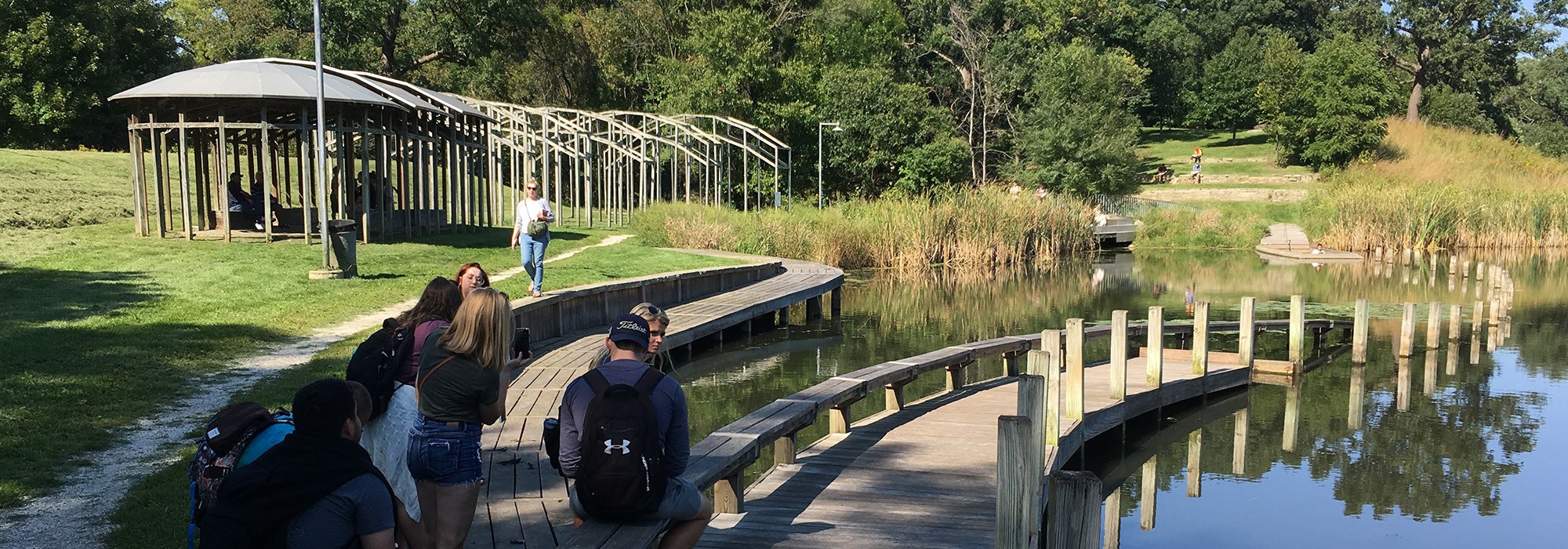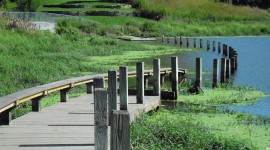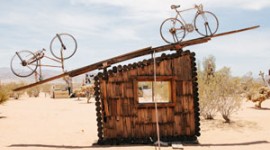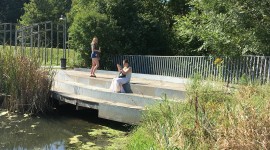Surprising Revelations At “Greenwood Pond: Double Site” Court Hearing
There were some surprising revelations in a more than three-hour-long hearing about a preliminary injunction in a Des Moines federal court on Thursday April 18. The Des Moines Art Center’s Director, Kelly Baum, and its Board of Trustees are willing to spend more than $350,000 to destroy Greenwood Pond: Double Site, but they adamantly refuse to restore the ill-maintained and acclaimed land art installation created by artist Mary Miss that was commissioned for its permanent collection and opened in 1996. In addition, Mickey Ryan, the Art Center’s Director of Registration and Collections Management, testified the Art Center does not have precise records of ordinary maintenance for the installation, and she and Baum said they don’t even have a maintenance manual for the artwork, despite calls for the creation of one. Remarkably, Baum, who has been director for eleven months, said she did not become aware of the installation until “after [she] arrived.”

The day prior, Miss, art scholar Dr. Susanneh Bieber with Texas A&M University, Bambi Yost, Associate Professor of Landscape Architecture, Iowa State University, and Ben Arato, an attorney with Wandro, Kanne & Lalor representing Miss, toured the site; across the street were numerous “Save Greenwood Pond” yard signs. While the artwork’s condition is compromised and some sections are fenced off, its integrity is very high. During their visit they met a fourteen-year-old who was fishing from the artwork’s elevated viewing pavilion. He was thrilled to meet and discuss the site, which he visits weekly, with the artist and Bieber, and expressed his concerns about the planned demolition.

Miss’ suit, filed on April 4, claims the Art Center breached its 1994 contract with her, and calls for the terms of the contract to be enforced, and is in violation of the Visual Artists Rights Act (VARA) of 1990 concerning the “destruction of a work of recognized stature, and any intentional or grossly negligent destruction of that work.” Baum claims restoration would cost $2.65 million and told the artist “we do not and will not ever have the money” for the work. On April 8, Judge Stephen Locher of the U.S. District Court for the Southern District of Iowa, issued a temporary restraining order (which was extended twice to May 3). A preliminary injunction is the next step.
Numerous local supporters of the artist and her artwork attended the hearing including David and Stephanie Joiner, who founded the local group Save Greenwood Pond. The artist flew in from New York City to testify, Bieber and Yost were present as expert witnesses, and Mike Draper, Founder and Owner of the Des Moines-based business RAYGUN, provided important local perspectives. A representative from The Cultural Landscape Foundation (TCLF), which first revealed the Art Center's demolition plans and has been spearheading the national advocacy campaign on the artwork's behalf, was also in attendance.
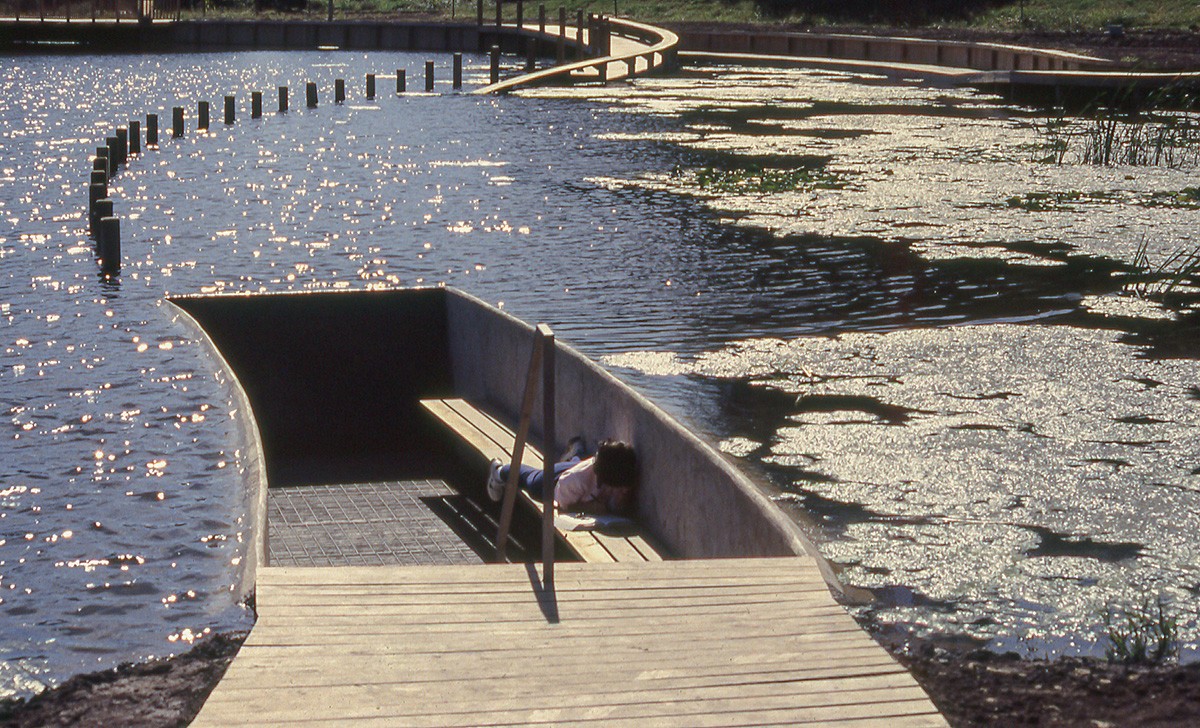
Bieber, the first witness of the day, testified that Mary Miss is a “towering figure in the history of art.” She described land art as being more publicly accessible than art encountered inside museums because they’re in out in the open. Miss’ deliberate use of common materials – wood, metal mesh, concrete – make the artist’s works even more accessible because their very ordinariness and familiarity renders the distinction between art and the everyday minimal. Moreover, Bieber said Greenwood Pond: Double Site was directly related to and a more complex version of one of Miss’ most acclaimed works, Perimeters/Pavilions/Decoys (1978), a temporary installation that she has recently written about, and was a fulcrum the artist’s career that led to the creation of the non-profit City as Living Laboratory (CALL).
Yost followed and testified that since 2011 she annually takes her students to Greenwood Pond: Double Site because it’s the only example of land art in Iowa and an excellent place at which to learn about and understand the distinction between landscape architecture and land art. Yost said despite the work’s current condition, the story it tells is still completely evident. Draper testified he’d been in touch with several Art Center Board Members including Dawn Martinez Oropeza who emailed on March 25, 2024, saying "there is a lot of information and 'evidence' that aren’t being shared. As board members we don’t have access to everything or all the information." Importantly, this was almost one month after the Board voted unanimously to deaccession the artwork on February 27.

Miss was the final person to testify in support of the artwork. She noted two earlier works that use similar materials that were created a decade before Greenwood Pond: Double Site have been properly maintained: South Cove (1987) in Battery Park City, N.Y. and Pool Complex: Orchard Valley (1982-85) in the Laumeier Sculpture Park in St. Louis, MO.
Miss and attorney Arato also discussed a July 2012 letter she’d sent to the previous Art Center director that Baum recently claimed as evidence Miss agreed “to deinstall the work if it was not feasible to repair it.” In fact, Miss’ letter concerned efforts to restore the artwork and included suggestions of specific possible funding sources, none of which she was aware the Art Center pursued. Miss also said: “a maintenance program (which of course implies funding) needs to be in place.” This, too, the Art Center failed to do.
In recounting her October-November 2023 emails and one Zoom call with Baum, Miss said she was not consulted about demolition. She also said the Art Center’s $2.65 million restoration estimate “seems very high” and wanted the option to get another estimate. She was also not informed about the Art Center Board’s February 27, 2024, vote to deaccession the work. In answer to Knowles, the Art Center’s attorney, Miss said she is a sculptor who sculpts the land, and that Greenwood Pond: Double Site was designed to be preserved in its entirety.

Baum was the first witness for the Art Center. She cited a September 6, 2023, email from Ben Page, the city’s Director of Parks and Recreation, as the trigger for investigating the artwork’s condition. She and her newly hired Director of Facilities, Mike Gard, walked the site, determined there were problems, and secured structural engineer John Rhodes who did a “walk through” and concluded in an email that “[t]here are some significant structural concerns.” He also wrote: “major sections will need to be completely rebuilt. It does not sound like this work will happen the season. There is really no urgency once the areas are closed off.” The latter observation undercuts the Art Center’s insistence the work be immediately demolished.
In recounting her November 13 Zoom call with Miss, Baum said she wanted to get to know the artist better and understand Miss’ intention for the artwork. They spoke about the history and lifespan of the wood and the need to work within a budget. They did not discuss avenues for moving forward. Baum also testified the restoration costs were not feasible. She noted it took two years to raise $300,000 for work in 2012-15, and that she contacted her “most trusted donors” and none would cover any of the restoration costs. She testified that deaccessioning discussions began in January as the issue “had come to an impasse” (presumably because Baum told Miss on December 1, 2023, “we do not and will not ever have money to replace it").
Attorney Arato queried Baum about the deaccessioning document that she and the Art Center’s Ryan had prepared for the Board. He cited an important omission in the document’s opening paragraph, which stated that the deaccession decision was “guided by three documents: the Art Center’s 1990 agreement with the City of Des Moines; our Collections Management Policy; and the Association of Art Museum Directors’ (AAMD’s) rigorous deaccessioning protocols, found in ‘Professional Practices in Art Museums.’” Notably missing was mention of the Art Center’s 1994 contract with the artist. Baum said they “did consider” the contract, which was incorrectly dated and buried among 170 pages of supporting documents.

In addition, in a deft pretrial filing, Arato sought to dismantle the Art Center’s justification for demolition. He pointed out that by “incorrectly equating ‘cost’ as ‘value’ that the Art Center arrives at its dubious conclusion that [Greenwood Pond: Double Site] ‘requires conservation far in excess of its value.’” Arato also disputed whether the Art Center’s leadership was abiding by AAMD deaccessioning guidelines, which state: “Deaccessioning …must observe any terms or obligation that pertain to the acquisition of the work by the museum [emphasis added]”; i.e. the 1994 contract with the artist. The guidelines also note: “(2) Third-party review and appraisal may be considered in the case of objects of substantial value. (3) In the case of work(s) by a living artist, special consideration may apply.” “Mary Miss,” he wrote, “is the living artist. She should have the opportunity to submit such a third-party review.”
At the hearing's conclusion Judge Locher said he would have a decision by Friday, April 26. When given an opportunity to provide closing remarks, Knowles, the Art Center’s attorney, made a startling declaration: since the Greenwood Pond: Double Site is not a painting, photograph, print, drawing, or traditional sculpture, it’s not a work of visual art and therefore not covered by VARA. It should be noted that VARA has no qualifying language about the type of sculpture protected.



